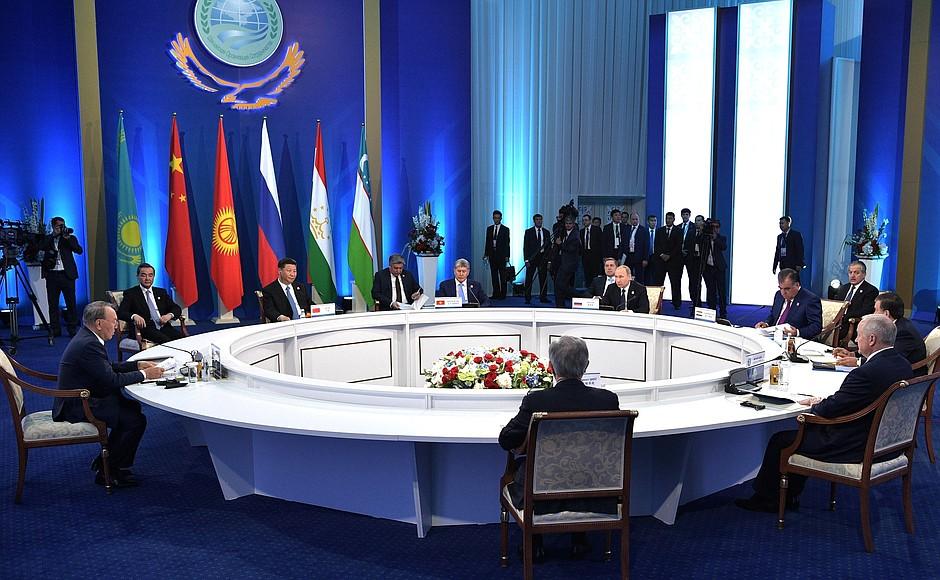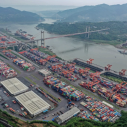Is the Silk Road a Road of Fear? Challenges of Global Transformation
archive


Photo: Johannes Eisele/AFP/Getty Images
Is the Silk Road a Road of Fear? Challenges of Global Transformation
The concept of the Silk Road calls up a variety of images and ideas. As the range and global interrelatedness of the Belt and Road Initiative (BRI) shows, a new kind of globalization may arise out of it that may become a driver of “re-globalization” (Benedikter and Kofler 2019). Within this framework, it is essential to understand the mechanisms and concepts behind BRI, which are floating at the interface of a variety of global projects, international reactions, regional effects, and the necessity of a “Global Transformation Design.”
The term “Silk Road” has always been less a specific route than it is a large number of routes and paths “between the Orient and the Occident,” between East and West, between seemingly distant lands offering special products and goods. It still exists, now in the form of the “New Silk Road”—a term that persists despite China’s attempt to adopt “One Belt One Road” (OBOR) in 2013, which distinguished between a continental group of routes (the “Silk Road Economic Belt”) and a maritime group (the “Maritime Silk Road”). These evolved into the “Belt and Road Initiative” (BRI), which describes—without characterizing it as such—what is perhaps the world’s largest globalization project: more than 60 countries participating in an essentially global development and investment project.1
On the surface, it looks as though China is primarily developing modern trade routes and to some extent financing them.2 Even though a kind of globalization strategy began to emerge in the 1980s—for instance with the approval of direct foreign investments—and although China gradually became the most important global producer of industrial goods, it was also clear that China would not limit itself to being the “workbench of the world”—not least because it was in the process of raising hundreds of millions of Chinese people out of poverty and creating a new middle class thanks to its economic growth strategy.3,4 Increasingly, China is becoming a provider of high-quality goods and products for global markets, and the corridors and routes of the BRI aid these developments. They also bolster China’s declared objectives regarding peaceful cooperation for global development.5
It is becoming clear that this expansion and global development to find new markets and to secure raw materials makes a great deal of sense from China’s perspective. But what are the consequences of the planned and, in some cases, already realized enormous investments in port facilities, oil and gas pipelines, railways, free trade zones, and airports in a large number of countries? What does this mean from an economic, political, military, cultural, social, and ecological perspective—on a global scale, but also on a regional scale?6 Can the declared emphasis on equal participation by the involved states be implemented?
With the development of BRI as a globalization strategy, China seems to be successfully deploying the narrative of the historical Silk Road to gain influence in a large number of countries. There is good reason to assume that China aims to use BRI to achieve the upper hand in evolving worldwide globalization dynamics, and may be planning to implement a new, initially economically-dominated framework of “global governance.” On the one hand, this strategy astonishes the world and gains admiration, given the impressive speed of developments. On the other, global criticism and concern about China’s activities grow at the same time as expanding bilateral agreements with China. Meanwhile, questions about its interactions with other governments and populations are constantly causing diplomatic difficulties.
Competing Capitalisms
Nowhere else in the world is the fight for interpretive dominance about the future of capitalism more apparent than on and along the Silk Roads. Over the past hundred years China has developed a state-dominated form of political capitalism that drives high economic growth while limiting individual political and personal rights. It stands in direct contrast to the West’s “liberal meritocratic” form, which is embedded in the context of democracy and the rule of law but is also associated with the challenge of economic and social inequality (a problem that is also increasing dramatically in China). These differing interpretations of capitalism will determine worldwide globalization dynamics in the future. As noted by Milanovic’ (2020), the “New Silk Road” globalization project could be interpreted as a vehicle for exporting China’s brand of political capitalism. BRI is an attempt to secure political and economic spheres of influence worldwide. The Chinese offering, with massive infrastructure development and international networking of these infrastructures, is tempting for many countries—in part because it stimulates politically popular growth in those countries, and in part because the countries are cash-strapped and are therefore more willing to sell attractive infrastructures to Chinese companies, in whole or in part.7
There is good reason to assume that China aims to use BRI to achieve the upper hand in evolving worldwide globalization dynamics, and may be planning to implement a new, initially economically-dominated framework of “global governance.”
In the discussion about various forms of capitalism one player is hardly ever mentioned, particularly in conjunction with the Silk Road project: the Russian Federation. Some of the BRI corridors cross through Russia itself, but it is mainly the Central Asian and Eurasian region that is traversed by historical and modern Silk Road routes. Nevertheless, even after the collapse of the Soviet Union, this region remains within the Russian sphere of influence. These developments create identity crises and feelings of inferiority in the Central Asian countries, which (to varying degrees) are “supported” by Moscow. The collapse of the Soviet Union marked the start of rampant, uncontrolled privatization of state property, while the population was left practically empty-handed. Anyone who travels through the countries of Central Asia and the Caucasus today can see their impoverished circumstances first-hand, along with the countries’ efforts to escape from this relative poverty one step at a time—something that is nearly impossible without external finance and concrete collaborative development projects.8 China is willing and able to fill this vacuum, a circumstance that the region generally welcomes despite a sense of trepidation, particularly in the poorer countries. With China’s influence on the Central Asian nations becoming increasingly apparent and Russia an economic junior partner in region, it will be interesting to see what kind of political arrangement the two countries reach in the future.
Technological and Cultural ‘Supremacy’?
China is on its way to worldwide dominance in the fields of digitization and artificial intelligence technology. Its rapid social development is enmeshed with technological developments, which results among other things in the new Chinese middle classes having few problems with state taxation and surveillance. In fact, the “smart home” and “smart city” represent major political and societal accomplishments. However, anyone who has visited the traditionally Muslim northwestern Chinese province of Xinjiang might already suspect that the “smart city” is about more than just efficient (digital) services for citizens. The project of developing the Silk Road also has a digital dimension, which thus far has been most noticeable in China itself. Future rules, for instance regarding data privacy, will come from the (global) confrontation between democratic and authoritarian systems. And rules will also emerge from the introduction of a social, points-based system in the People’s Republic of China—not least because it will apply not only to citizens, but also to companies9. The same is true of the “New Silk Road,” which will create a basis for new global standards and rules in various sectors, areas, and industries. Thus the major question for China in regard to the New Silk Road project is whether it will be possible to adjust many of the standards and regulations (for e.g. in the energy sector), or whether new ones must be created.

Chinese, Russian, and Central Asian leaders at the 2017 Shanghai Cooperation Organization (SCO) Summit in Astana, Kazakhstan.
At the beginning, we noted that the Belt and Road Initiative is primarily a system of corridors and routes for the logistics and transport of goods and products. But it is already becoming clear that, in addition to this trade-related mandate, the social and cultural realm will also provide further development stimulus through international exchange2. The narrative of the historical Silk Road used in tourism, as well as of the logistics corridors with their infrastructures and services, are becoming more and more blurred. A “Digital Silk Road” that operates through a “platform economy” supports unanticipated new possibilities for networks and relationships. These unanticipated possibilities are also the root of a great share of the fear that may arise through uncertainty and lack of real knowledge about BRI. Uncertainty, because available information about projects, motivations, conditions, and standards lacks transparency. Fears could arise in other areas: about uneven development speeds, about differing interpretations of technological developments and their impact on politics and society, and about economic power and resulting practical realities such as fear of debt. Fears arise when new borders are created between countries (for instance between the countries of the former Soviet Union in the Central Asian region); they also emerge when countries fear their minorities or when cultural circumstances and artifacts are reinterpreted, often through the vector of tourism.
Nevertheless, the “New Silk Road” is a strategic project of global significance that needs to be steered and designed carefully in a phase of re-globalization. The Chinese people can be expected to learn from international criticism and pragmatically further develop the project one step at a time.10 And the global players in the United States and Europe can be expected to move away from criticism and to develop appropriate responses, solutions, and concepts in the service of a new global dynamic that will see various approaches to capitalism and various norms and standards to develop a global core competence. We could eventually call this competence “Global Transformation Design,” as it holds the potential to bridge, connect, and integrate the 5 R’s of Re-Globalization in a balanced way.
1. Belt and Road Portal (2019): Six Years of "Belt and Road"! Available online at https://eng.yidaiyilu.gov.cn/qwyw/rdxw/105854.htm, updated on 11/10/2019, checked on 12/22/2019.
2. Pechlaner, H.; Thees, H.; Manske-Wang, W.; Scuttari, A. (2019): “Local service industry and tourism development through the global trade and infrastructure project of the New Silk Road – the example of Georgia.” In The Service Industries Journal 9 (3), pp. 1–27. DOI: 10.1080/02642069.2019.1623204.
3. Milanovic, Branko (2020): “The Clash of Capitalisms. The Real Fight for the Global Economy's Future.” In Foreign Affairs (January/ February), pp. 10–21.
4. Frankopan, Peter (2016): The silk roads. A new history of the world. Paperback edition. London, Oxford, New York, New Delhi, Sydney: Bloomsbury.
5. Belt and Road Portal (2015): Action plan on the Belt and Road Initiative. Available online at http://english.www.gov.cn/archive/publications/2015/03/30/content_281475..., updated on 5/30/2015, checked on 1/7/2020.
6. Pechlaner, H., Erschbamer, G., Thees, H., Gruber, M. (Eds.) (2020, forthcoming). China and the New Silk Road. Challenges and Impacts on the Regional and Local Level. Cham: Springer Switzerland.
7. Łasak, Piotr; van der Linden, René W. H. (2020): The Financial Implications of China's Belt and Road Initiative. A Route to More Sustainable Economic Growth. Cham: Springer International Publishing AG.
8. Fatland, Erika (2019): Sovietistan. Travels in Turkmenistan, Kazakhstan, Tajikistan, Kyrgyzstan and Uzbekistan. London: Maclehose Press.
9. Cheng, Evelyn (2019): “China is building a 'comprehensive system' for tracking companies' activities, report says.” CNBC News. Available online at https://www.cnbc.com/2019/09/04/china-plans-for-corporate-social-credit-..., updated on 9/3/2019, checked on 1/7/2020.
10. Eisenman, Joshua; Stewart, Devin T. (2019): China’s Global Critics Are Helping It Win. Edited by Foreign Policy. Available online at https://foreignpolicy.com/2019/10/30/china-united-states-belt-road-china..., updated on 10/30/2019, checked on 1/7/2020.




